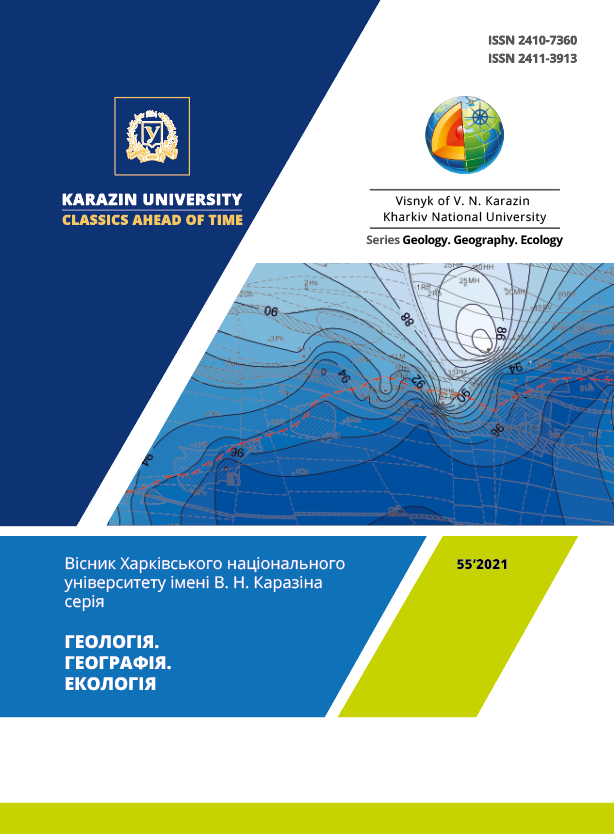Peculiarities of engineering and geological surveys when inspecting the historical building of Kharkiv
Abstract
Formulation of the problem. The large volume of historic buildings that require major repairs, reconstruction and adaptation to modern use dictates the need to move to faster and more reliable technologies of architectural monuments restoration. In this regard, there is a need for a complex approach during the restoration work.
The purpose of the article is to investigate the difficulty of obtaining the correct conclusions about the geological conditions of the building placement as a result of previously unqualified repair works on the example of engineering-geological surveys during the reconstruction of a historic building.
Materials and methods. To achieve the goal, the analysis of engineering-geological conditions of the soil base of the building, visual inspection of the building, soil sampling from the pits in the basement of the survey object, as well as determining the physical-mechanical characteristics of the soil have been done. An analytical comparison of these data was performed to understand the constructive solution of the building foundations and engineering-geological conditions of their support.
Results. During the working process, the lack of design and executive documentation for the building, as well as unqualified interference in its structure, was revealed. Therefore, one of the key issues was to determine the actual structure of the foundation, as well as the type and condition of its soil base. As a result of a complex analysis of the structural scheme of the underground part of the building, it was established that the basement was equipped after the construction of the building. To determine the structure, depth and condition of the foundation, pits were laid from the frontal and back walls of the building facade, which is adjacent to the site. During the laboratory studies of the soils, physical-mechanical characteristics were obtained for calculating building structures. Based on the data obtained, recommendations were issued for the further reconstruction of a non-residential building of the historical development of the city.
Scientific novelty and practical significance. The necessity to research the actual technical state of building structures of a historical building is substantiated to assess the possibility of further reliable and safe operation according to its direct functional purpose, with the development of technical solutions and recommendations for further reconstruction of the building according to the needs of the customer, and ensuring its further uninterrupted and safe ope-ration.
The practical application of the proposed results has been substantiated - the need for a complex approach during the restoration work for the further reconstruction of a non-residential building of the historical buildings of the city has been confirmed.
Downloads
References
Bosenko E. V. (2019). Analiz kharakteristik tsennogo istoricheskogo zdaniya s tsel'yu vyyavleniya resursnogo po-tentsiala prisposobleniya k sovremennomu ispol'zovaniyu. [Analysis of the characteristics of a valuable historic building in order to identify the resource potential of adaptation to modern use]. Arkhitektura: sb. nauch. tr. Minsk, 12, 206–212. [in Russian]
Klimenko І. (2006). Otsіnka pamyatok іstorії, arkhіtekturi ta mіstobuduvannya. [Assessment of monuments of histo-ry, architecture and urban planning]. Kyiv: ArtEk, 287. [in Russian]
Prybieha L. V. (2010). Arkhitekturna pamiatkookhoronna metodyka yak naukova dystsyplina. [Architectural conser-vation techniques as a scientific discipline]. Pratsi tsentru pamiatkoznavstva: naukovyi zbirnyk. Kyiv, 17, 16–21. Available at: http://dspace.nbuv.gov.ua/handle/123456789/79443 [in Ukrainian]
Rosenfeld Y. (1999). Decision support model for semi-automated selection of renovation alternatives. Automation in Construction, 8, 503–510. [in English]. DOI: https://doi.org/10.1016/s0926-5805(98)00097-1
Douglas J. (2006). Building Adaptation: Second Edition. Oxford: Butterworth- Heinemann, 651.
Frediani P. (2013). Cultural Heritage: Protection, Developments and International Perspectives. New York: Nova Science Publishers, 312.
Akulenko V. I. (2013). Mizhnarodne pravo okhorony kulturnykh tsinnostei ta yoho implementatsiia u vnutrishnomu pravi Ukrainy [International law of protection of cultural values and its implementation in the domestic law of Ukraine]. Kyiv: Yustinian, 616. [in Ukrainian]
Green M. (2012). Building codes for existing and historic buildings. Hoboken, New Jersey: John Wiley&Sons, Inc., 248.
Kondel-Perminova N. (2008). Intehratsiia pamiatok arkhitektury ta mistobuduvannia v suchasnyi sotsiokulturnyi kontekst [Integration of architectural and urban monuments into the modern socio-cultural context]. Suchasni problemy doslidzhennia, restavratsii ta zberezhennia kulturnoi spadshchyny: zb. nauk. pr. z mystetstvoznavstva, arkhitekturoznavstva y kulturolohii. Kyiv, 5, 94–112. Available at: http://nbuv.gov.ua/UJRN/Spdr_2008_5_8. [in Ukrainian]
Cullinane J. (2003). Maintaining and Repairing Old and Historic Buildings. Hoboken, New Jersey: John Wiley&Sons, Inc., 260.
Bielomiesiatsev A. B. (2008). Ekonomichni osnovy arkhitektury. Kyiv: Feniks, 400. [in Ukrainian]
Wilkinson S. J. (2014). Sustainable Building Adaptation: Innovations in Decision- making: Innovations in Deci-sion-making. Chichester: Wiley, 2011.
Gorse C. (2009). Refurbishment and Upgrading of Buildings. Second edition. London: Spon Press, 263.
Lesyk O. V. (2013). Pryntsypy restavratsii pamiatok arkhitektury. [Principles of restoration of architectural monu-ments. Traditions and innovation]. Tradytsii ta novatorstvo. Ukrainska akademiia mystetstv, 21, 97–103. Available at: http://nbuv.gov.ua/j-pdf/Uam_2013_21_13.pdf [in Ukrainian]
Schittich C. (2015). Refurbishment: Best of Detail. Herausgeber, 200.
Giebeler G. (2009). Refurbishment Manual: maintenance conversions extensions. Basel: Birkhduser, 279.
Schittich C. (2003). Building in Existing Fabric: Refurbishment, Extensions New Design. Basel: Birkhäuser Archi-tecture, 176.
Artishevskyi A. E. (2007). Deiaki aspekty zberezhennia i vykorystannia zberezhennia kulturnoi spadshchyny. [Some aspects of preservation and use of cultural heritage preservation]. Suchasni problemy doslidzhennia, restavratsii ta zberezhennia kulturnoi spadshchyny: zb. nauk. pr. z mystetstvoznavstva, arkhitekturoznavstva y kulturolohii. Ky-iv, 4, 392–396. [in Ukrainian]
Wilkinson S. J. (2014). Sustainable Building Adaptation: Innovations in Decision-Sustainable Building Adapta-tion: Innovations in Decision-making. Chichester: Wiley, 2011.
Partyka R. (2014). Arkhitekturno-planuvalna rekonstruktsiia ta suchasne vykorystannia pamiatok arkhitektury. [Architectural and planning reconstruction and modern use of architectural monuments]. Visnyk Lvivskoho natsionalnoho ahrarnoho universytetu, 15, 173–177. Available at: http://nbuv.gov.ua/j-pdf/Vldau_2014_15_31.pdf. [in Ukrainian]
Aleksandrovych V. A., Havryliuk O. V. (2021). Investigation of the Influence of Dynamic Loads of Industrial Equip-ment on the Occurrence of Prolonged Yielding of their Foundation Soils. IOP Conf. Series: Materials Science and Engineering, 1021(1) 012010. DOI: https://doi.org/10.1088/1757-899X/1021/1/012010
Levenko H. M., Aleksandrovych V. A. (2021). Reconstruction of Shallow Foundations Using Peracetic Silicate So-lutions. IOP Conf. Series: Materials Science and Engineering, 1021(1) 012010. DOI: https://doi.org/10.1088/1757-899X/1021/1/012020





